Wenhai Wang
ViCO: A Training Strategy towards Semantic Aware Dynamic High-Resolution
Oct 14, 2025Abstract:Existing Multimodal Large Language Models (MLLMs) suffer from increased inference costs due to the additional vision tokens introduced by image inputs. In this work, we propose Visual Consistency Learning (ViCO), a novel training algorithm that enables the model to represent images of varying semantic complexities using different numbers of vision tokens. The key idea behind our method is to employ multiple MLP connectors, each with a different image compression ratio, to downsample the vision tokens based on the semantic complexity of the image. During training, we minimize the KL divergence between the responses conditioned on different MLP connectors. At inference time, we introduce an image router, termed Visual Resolution Router (ViR), that automatically selects the appropriate compression rate for each image patch. Compared with existing dynamic high-resolution strategies, which adjust the number of visual tokens based on image resolutions, our method dynamically adapts the number of visual tokens according to semantic complexity. Experimental results demonstrate that our method can reduce the number of vision tokens by up to 50% while maintaining the model's perception, reasoning, and OCR capabilities. We hope this work will contribute to the development of more efficient MLLMs. The code and models will be released to facilitate future research.
ScaleCUA: Scaling Open-Source Computer Use Agents with Cross-Platform Data
Sep 18, 2025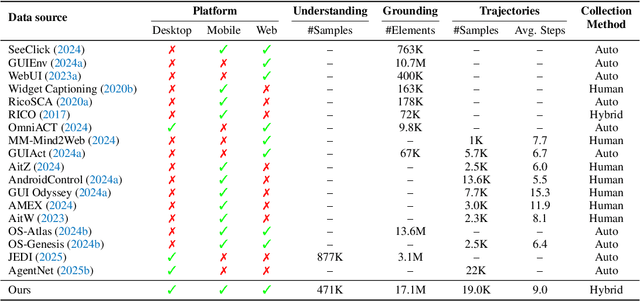
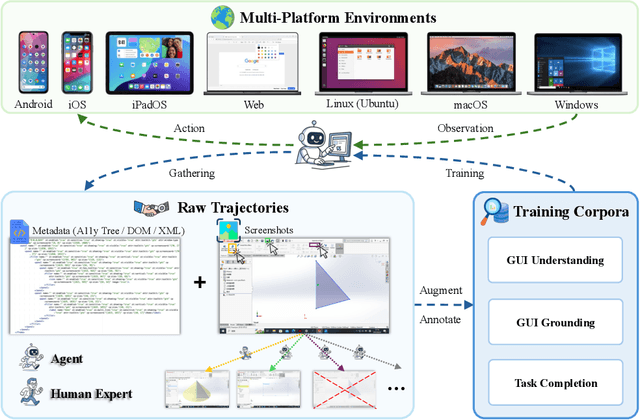
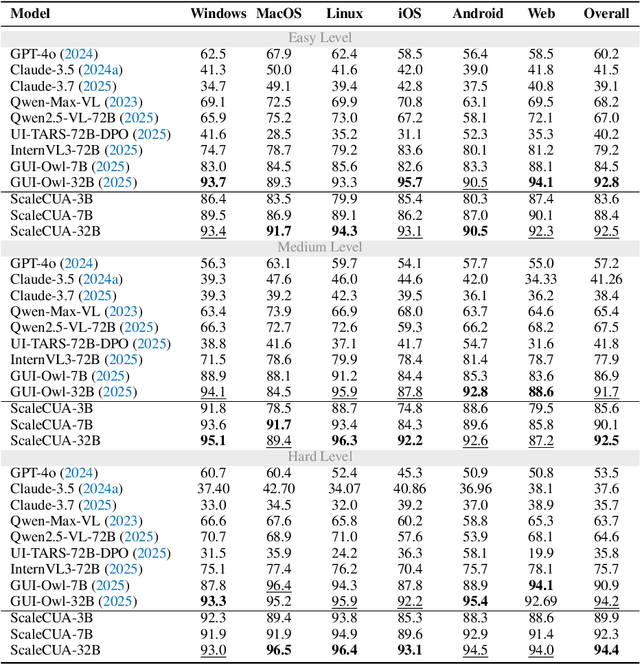
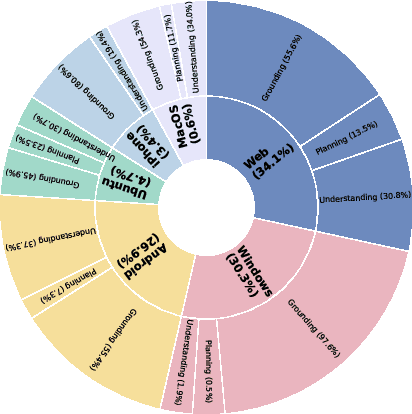
Abstract:Vision-Language Models (VLMs) have enabled computer use agents (CUAs) that operate GUIs autonomously, showing great potential, yet progress is limited by the lack of large-scale, open-source computer use data and foundation models. In this work, we introduce ScaleCUA, a step toward scaling open-source CUAs. It offers a large-scale dataset spanning 6 operating systems and 3 task domains, built via a closed-loop pipeline uniting automated agents with human experts. Trained on this scaled-up data, ScaleCUA can operate seamlessly across platforms. Specifically, it delivers strong gains over baselines (+26.6 on WebArena-Lite-v2, +10.7 on ScreenSpot-Pro) and sets new state-of-the-art results (94.4% on MMBench-GUI L1-Hard, 60.6% on OSWorld-G, 47.4% on WebArena-Lite-v2). These findings underscore the power of data-driven scaling for general-purpose computer use agents. We will release data, models, and code to advance future research: https://github.com/OpenGVLab/ScaleCUA.
GenExam: A Multidisciplinary Text-to-Image Exam
Sep 17, 2025Abstract:Exams are a fundamental test of expert-level intelligence and require integrated understanding, reasoning, and generation. Existing exam-style benchmarks mainly focus on understanding and reasoning tasks, and current generation benchmarks emphasize the illustration of world knowledge and visual concepts, neglecting the evaluation of rigorous drawing exams. We introduce GenExam, the first benchmark for multidisciplinary text-to-image exams, featuring 1,000 samples across 10 subjects with exam-style prompts organized under a four-level taxonomy. Each problem is equipped with ground-truth images and fine-grained scoring points to enable a precise evaluation of semantic correctness and visual plausibility. Experiments show that even state-of-the-art models such as GPT-Image-1 and Gemini-2.5-Flash-Image achieve less than 15% strict scores, and most models yield almost 0%, suggesting the great challenge of our benchmark. By framing image generation as an exam, GenExam offers a rigorous assessment of models' ability to integrate knowledge, reasoning, and generation, providing insights on the path to general AGI.
InternVL3.5: Advancing Open-Source Multimodal Models in Versatility, Reasoning, and Efficiency
Aug 25, 2025Abstract:We introduce InternVL 3.5, a new family of open-source multimodal models that significantly advances versatility, reasoning capability, and inference efficiency along the InternVL series. A key innovation is the Cascade Reinforcement Learning (Cascade RL) framework, which enhances reasoning through a two-stage process: offline RL for stable convergence and online RL for refined alignment. This coarse-to-fine training strategy leads to substantial improvements on downstream reasoning tasks, e.g., MMMU and MathVista. To optimize efficiency, we propose a Visual Resolution Router (ViR) that dynamically adjusts the resolution of visual tokens without compromising performance. Coupled with ViR, our Decoupled Vision-Language Deployment (DvD) strategy separates the vision encoder and language model across different GPUs, effectively balancing computational load. These contributions collectively enable InternVL3.5 to achieve up to a +16.0\% gain in overall reasoning performance and a 4.05$\times$ inference speedup compared to its predecessor, i.e., InternVL3. In addition, InternVL3.5 supports novel capabilities such as GUI interaction and embodied agency. Notably, our largest model, i.e., InternVL3.5-241B-A28B, attains state-of-the-art results among open-source MLLMs across general multimodal, reasoning, text, and agentic tasks -- narrowing the performance gap with leading commercial models like GPT-5. All models and code are publicly released.
CoMemo: LVLMs Need Image Context with Image Memory
Jun 06, 2025


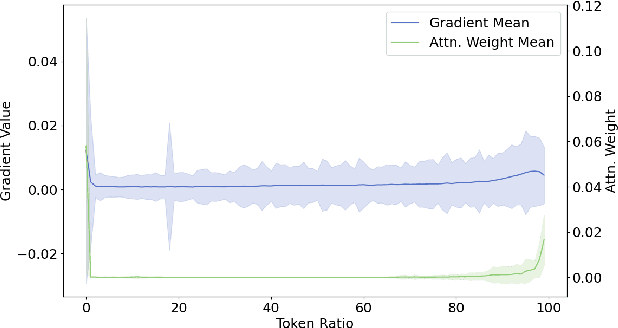
Abstract:Recent advancements in Large Vision-Language Models built upon Large Language Models have established aligning visual features with LLM representations as the dominant paradigm. However, inherited LLM architectural designs introduce suboptimal characteristics for multimodal processing. First, LVLMs exhibit a bimodal distribution in attention allocation, leading to the progressive neglect of middle visual content as context expands. Second, conventional positional encoding schemes fail to preserve vital 2D structural relationships when processing dynamic high-resolution images. To address these limitations, we propose CoMemo - a dual-path architecture that combines a Context image path with an image Memory path for visual processing, effectively alleviating visual information neglect. Additionally, we introduce RoPE-DHR, a novel positional encoding mechanism that employs thumbnail-based positional aggregation to maintain 2D spatial awareness while mitigating remote decay in extended sequences. Evaluations across seven benchmarks,including long-context comprehension, multi-image reasoning, and visual question answering, demonstrate CoMemo's superior performance compared to conventional LVLM architectures. Project page is available at https://lalbj.github.io/projects/CoMemo/.
OWMM-Agent: Open World Mobile Manipulation With Multi-modal Agentic Data Synthesis
Jun 04, 2025Abstract:The rapid progress of navigation, manipulation, and vision models has made mobile manipulators capable in many specialized tasks. However, the open-world mobile manipulation (OWMM) task remains a challenge due to the need for generalization to open-ended instructions and environments, as well as the systematic complexity to integrate high-level decision making with low-level robot control based on both global scene understanding and current agent state. To address this complexity, we propose a novel multi-modal agent architecture that maintains multi-view scene frames and agent states for decision-making and controls the robot by function calling. A second challenge is the hallucination from domain shift. To enhance the agent performance, we further introduce an agentic data synthesis pipeline for the OWMM task to adapt the VLM model to our task domain with instruction fine-tuning. We highlight our fine-tuned OWMM-VLM as the first dedicated foundation model for mobile manipulators with global scene understanding, robot state tracking, and multi-modal action generation in a unified model. Through experiments, we demonstrate that our model achieves SOTA performance compared to other foundation models including GPT-4o and strong zero-shot generalization in real world. The project page is at https://github.com/HHYHRHY/OWMM-Agent
Point or Line? Using Line-based Representation for Panoptic Symbol Spotting in CAD Drawings
May 29, 2025Abstract:We study the task of panoptic symbol spotting, which involves identifying both individual instances of countable things and the semantic regions of uncountable stuff in computer-aided design (CAD) drawings composed of vector graphical primitives. Existing methods typically rely on image rasterization, graph construction, or point-based representation, but these approaches often suffer from high computational costs, limited generality, and loss of geometric structural information. In this paper, we propose VecFormer, a novel method that addresses these challenges through line-based representation of primitives. This design preserves the geometric continuity of the original primitive, enabling more accurate shape representation while maintaining a computation-friendly structure, making it well-suited for vector graphic understanding tasks. To further enhance prediction reliability, we introduce a Branch Fusion Refinement module that effectively integrates instance and semantic predictions, resolving their inconsistencies for more coherent panoptic outputs. Extensive experiments demonstrate that our method establishes a new state-of-the-art, achieving 91.1 PQ, with Stuff-PQ improved by 9.6 and 21.2 points over the second-best results under settings with and without prior information, respectively, highlighting the strong potential of line-based representation as a foundation for vector graphic understanding.
ZeroGUI: Automating Online GUI Learning at Zero Human Cost
May 29, 2025Abstract:The rapid advancement of large Vision-Language Models (VLMs) has propelled the development of pure-vision-based GUI Agents, capable of perceiving and operating Graphical User Interfaces (GUI) to autonomously fulfill user instructions. However, existing approaches usually adopt an offline learning framework, which faces two core limitations: (1) heavy reliance on high-quality manual annotations for element grounding and action supervision, and (2) limited adaptability to dynamic and interactive environments. To address these limitations, we propose ZeroGUI, a scalable, online learning framework for automating GUI Agent training at Zero human cost. Specifically, ZeroGUI integrates (i) VLM-based automatic task generation to produce diverse training goals from the current environment state, (ii) VLM-based automatic reward estimation to assess task success without hand-crafted evaluation functions, and (iii) two-stage online reinforcement learning to continuously interact with and learn from GUI environments. Experiments on two advanced GUI Agents (UI-TARS and Aguvis) demonstrate that ZeroGUI significantly boosts performance across OSWorld and AndroidLab environments. The code is available at https://github.com/OpenGVLab/ZeroGUI.
EvoMoE: Expert Evolution in Mixture of Experts for Multimodal Large Language Models
May 28, 2025Abstract:Recent advancements have shown that the Mixture of Experts (MoE) approach significantly enhances the capacity of large language models (LLMs) and improves performance on downstream tasks. Building on these promising results, multi-modal large language models (MLLMs) have increasingly adopted MoE techniques. However, existing multi-modal MoE tuning methods typically face two key challenges: expert uniformity and router rigidity. Expert uniformity occurs because MoE experts are often initialized by simply replicating the FFN parameters from LLMs, leading to homogenized expert functions and weakening the intended diversification of the MoE architecture. Meanwhile, router rigidity stems from the prevalent use of static linear routers for expert selection, which fail to distinguish between visual and textual tokens, resulting in similar expert distributions for image and text. To address these limitations, we propose EvoMoE, an innovative MoE tuning framework. EvoMoE introduces a meticulously designed expert initialization strategy that progressively evolves multiple robust experts from a single trainable expert, a process termed expert evolution that specifically targets severe expert homogenization. Furthermore, we introduce the Dynamic Token-aware Router (DTR), a novel routing mechanism that allocates input tokens to appropriate experts based on their modality and intrinsic token values. This dynamic routing is facilitated by hypernetworks, which dynamically generate routing weights tailored for each individual token. Extensive experiments demonstrate that EvoMoE significantly outperforms other sparse MLLMs across a variety of multi-modal benchmarks, including MME, MMBench, TextVQA, and POPE. Our results highlight the effectiveness of EvoMoE in enhancing the performance of MLLMs by addressing the critical issues of expert uniformity and router rigidity.
ScienceBoard: Evaluating Multimodal Autonomous Agents in Realistic Scientific Workflows
May 26, 2025



Abstract:Large Language Models (LLMs) have extended their impact beyond Natural Language Processing, substantially fostering the development of interdisciplinary research. Recently, various LLM-based agents have been developed to assist scientific discovery progress across multiple aspects and domains. Among these, computer-using agents, capable of interacting with operating systems as humans do, are paving the way to automated scientific problem-solving and addressing routines in researchers' workflows. Recognizing the transformative potential of these agents, we introduce ScienceBoard, which encompasses two complementary contributions: (i) a realistic, multi-domain environment featuring dynamic and visually rich scientific workflows with integrated professional software, where agents can autonomously interact via different interfaces to accelerate complex research tasks and experiments; and (ii) a challenging benchmark of 169 high-quality, rigorously validated real-world tasks curated by humans, spanning scientific-discovery workflows in domains such as biochemistry, astronomy, and geoinformatics. Extensive evaluations of agents with state-of-the-art backbones (e.g., GPT-4o, Claude 3.7, UI-TARS) show that, despite some promising results, they still fall short of reliably assisting scientists in complex workflows, achieving only a 15% overall success rate. In-depth analysis further provides valuable insights for addressing current agent limitations and more effective design principles, paving the way to build more capable agents for scientific discovery. Our code, environment, and benchmark are at https://qiushisun.github.io/ScienceBoard-Home/.
 Add to Chrome
Add to Chrome Add to Firefox
Add to Firefox Add to Edge
Add to Edge